Best Way to Use a Handheld Ham in a House
The phone network is downward and the internet is inaccessible. 911 is overloaded. Power is out. How exercise you communicate when all else fails? Ham radio. We interruption it downwards in this one-page beginner's guide.
As recent disasters have shown, you lot only cannot rely on mobile phones or the internet to communicate in an emergency, because these communication channels depend on the electrical and data grid.
FEMA and the Carmine Cross oft rely on local Hams for spreading central info. When the devastating hurricanes of 2022 knocked out Puerto Rico'southward communications, Ham radio operators on the isle sprung to action, establishing crucial contact with rescue agencies.
You tin can think of countless situations where communication could make the difference between life and death on an individual level, too. What if disaster strikes when someone in your family is ten miles abroad at work? Or you have a medical emergency while camping?
Merely the trucker-cliche CB and "toy" versions of radio, like the common and cheap walkie-talkies anyone can buy and apply, aren't very useful in survival scenarios.
Amateur radio — likewise known as Ham radio — is the best overall way for preppers to keep in contact during an emergency.
Common sense prepping, straight to your inbox.
Get our costless newsletter for great new articles and giveaways. i-2 emails a month. 0% spam.
Ham radio seems like a complicated, technical, and expensive hobby. Some of that impression is justified considering the ham community has non done a good job of making things easy for people who desire to get started and proceed things elementary. There's also much technical jargon and besides many arguments over piffling just complicated things that don't affair to 99% of preppers.
Ham has been around for over 100 years, with 750,000 licensed operators in the United states and six million around the globe. It'south likewise the top choice for many preppers because of advantages in range, flexibility, community, and equipment compared to other options like CB and FRS.
You lot need a license from the FCC to communicate via a Ham radio. But with recent changes (like dropping the Morse code requirement), you tin can easily prepare for the test in just a few days using free online resources. The test is ordinarily simply $ten-fifteen. Combined with the advent of affordable and piece of cake-ish to use Ham radios, it's go much more practical to incorporate apprentice radio as role of your emergency preparedness.
In this guide:
- Common types of civilian radio: Ham, CB, FRS, GMRS, and MURS
- Why Ham radio is the best option for preppers and survival
- Criteria
- Contact with emergency services
- Crossover between radio types
- Ease of learning vs. benefits
- Costs
- What is the range of Ham radio, CB, FRS, GMRS, and MURS?
- Practise you lot need a license to use amateur Ham radio?
- Which Ham radio license is all-time for survival prepping?
- How to go a Ham radio license
- How to prepare for the Ham radio examination
- Intro to how radio works in easy terms
- Radio is part of a broader spectrum
- What are radio frequencies?
- What are radio wavelengths?
- What does HF, VHF, and UHF mean?
- What are radio bands?
- What are radio channels?
- The tradeoff between distance and penetration
- Ham radio repeaters can extend your range
- Intro to apprentice Ham radio equipment
Why you should trust us
We spent over 33 hours putting together this guide, and contributing experts have over 96 years of combined experience every bit Ham radio operators. Ham radio is too confusing for beginners, so it was our goal to provide but the right information to get you started and cutting through the noise.
Emergency radios: Ham vs. CB vs. FRS vs. GMRS vs. MURS
There are many types of radio, and they are not created equally.
In the US, the FCC sets bated blocks of radio frequencies for civilians to communicate with each other and benefit from the public airwaves that we all own. In later sections on this folio, we dig deeper into how the radio spectrum works.
Different blocks of frequencies have different names, rules, and pros/cons. These are the well-nigh relevant radio types:
- Amateur "Ham" radio
- Citizen's Ring (CB)
- Family Radio Service (FRS)
- Full general Mobile Radio Service (GMRS)
- Multi-Utilise Radio Service (MURS)
What makes these different? The government will specify things like the corporeality of power that tin can be used to transmit a signal, restrictions on equipment and antennas, whether you can use repeaters, available frequencies, so on.
Apprentice "Ham" Radio
ane.viii – 1300 MHz with gaps in between. Past far the widest range of frequency options.
Note that "Apprentice Radio" does not mean whatever broadcast radio used by civilians. In this case, "amateur" ways "non-commercial." You can't use it to make money. Even a not-profit radio station would be considered commercial because information technology's broadcast for the general public's benefit, rather than a communication from one person to some other.
Some volition refer to the other types (CB, FRS, etc) as "Personal Radio" to distinguish it from apprentice radio. The spiritual difference is that amateur radio is non-commercial but withal powerful and broad, where personal radio is specifically meant for families on a hike or truckers stuck in traffic.
Base of operations stations tin can legally exist up to 1,500 watts. A typical handheld Ham radio is 5-8 watts. There are fewer restrictions (if at all) on antennas, etc.
Citizens Band (CB)
26 – 27 MHz (HF), eleven meter ring, forty channels.
CB has been around a long fourth dimension, and was quite popular around the 1970'southward. CB has fallen out of favor in contempo years, although it's even so used by some truckers and offroading clubs. Information technology's unreliable, crowded, and the language can get pretty vulgar. You do not need a license to operate CB.
Power is limited to 4 watts. Fifty-fifty though that's more than power than MURS and FRS, CB still has lower quality because of interference from nearby channels (e.g. baby monitors), and it relies on AM technology instead of FM. There are ways you tin can tweak CB to be meliorate, just we think that's also complicated for most people. CB likewise requires much larger antennas considering of the longer wavelength compared to VHF/UHF.
Family Radio Service (FRS) vs. General Mobile Radio Service (GMRS)
462 – 467 MHz (UHF), 22 channels
These are technically two different radio types. Only they overlap on almost even so frequencies, can talk to each other on virtually of those frequencies, and in 2022 the FCC changed the rules and then that they became even more than similar. Considering of this, the popular radios sold in this category can commonly exercise both FRS and GMRS.
The FRS block was proposed by the RadioShack shop in the 1990s so families could speedily buy and utilize walkie-talkies that were better for personal use than CB, only didn't require a license. This lead to the growth of the common "chimera pack" paired radios you find in gas stations and Walmart.
GMRS is kinda-sorta the business equivalent of FRS. For example, farmers and businesses with employees spread effectually a small expanse would employ GMRS.
You still need a license to operate GMRS, which costs effectually $85, but there is no examination involved. GMRS could operate with upwardly to 50 watts of power, although most products are nevertheless 3-five watts.
GMRS is the only radio choice other than Ham that allows radio repeaters.
Multi-Utilise Radio Service (MURS)
151 – 154 MHz (VHF), 5 channels
MURS was created in 2000. It'south non very popular and generally not seen in prepping. You do non need a license to operate MURS. Power is limited to 2 watts.
However, some recent products marketed towards preppers are congenital on MURS in the groundwork, for example, the goTenna device that pairs with your phone to ship short text messages without the cell network. This product transmits over MURS to other nearby goTennas, creating a peer-to-peer radio network.
Ham radio is the all-time option for preppers
With all of these different types of radios, which one should you depend on when preparing for emergencies?
Nosotros consider these criteria when choosing:
- Point range in a variety of practical situations (urban, woods, etc.)
- How easy is it to learn and use
- Tin y'all mind to emergency broadcasts
- Can yous communicate with emergency services
- Overall cost to be properly prepared
- What kind of equipment is bachelor and does it fit well with emergency needs
- How like shooting fish in a barrel is it to alter and repair in normal life and an emergency
Whenever we brand a recommendation or draw a conclusion, nosotros normally like to show the information, testing, and reasoning that supported it.
In this case, since radio tin can get complicated pretty speedily and this is a beginner's guide, we can't put it all together in 1 linear section or explain every possible combination. For example, it'due south hard to understand differences in point range without first understanding how radio waves and radio equipment works.
"As a prepper, I turned to Ham over the other radio choices. When I idea about the wide range of scenarios that could bear on my family, Ham seemed like the best choice because of its power, range, and flexibility. I've been licensed for 11 years and still feel confident in my pick." — Ham veteran AJ Hoekstein.
Preppers generally concord Ham is the best choice because:
- Ham is the only pick where you can listen and talk to your local emergency services.
- Ham radio has a much wider range of frequencies than the others. CB can get quite crowded, for example, since everything happens betwixt 26 and 27 MHz.
- Ham has meliorate range. There is some nuance to this, explained below.
- Ham tin utilize High Frequency (HF) bands, which are the all-time bands in a major SHTF emergency because they can easily achieve hundreds of miles without depending on anything (or anyone) else.
- Ham has more power. Other forms are express to 0.5 – 4 watts. Handheld Ham units are typically 5-8 Westward, and base stations tin can go up to ane,500 W.
Listening to broadcasts and communicating with emergency services
Since nosotros're assuming the normal advice grid is down, how volition you get info from emergency services? How will you know if you should evacuate or when it's rubber to come out?
Many preppers have a NOAA emergency radio in their abode supplies. You can merely listen, merely it'south a unproblematic way to receive emergency broadcast radio stations like NOAA.
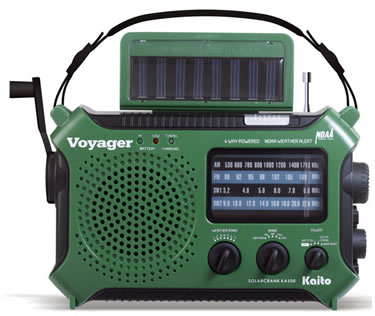
However, those radios, like the green one pictured here, can exist quite limited, inexpensive, and bulky. We generally don't recommend keeping these in your problems out purse or get dwelling bag.
Many portable Ham radios can listen to NOAA and commercial FM stations, too. Plus, you go the huge bonus of picking upwards and talking with your local emergency services (fire, constabulary, medical, etc.).
You lot'll also want to talk with other people in your family or customs, and to utilize equipment that is portable enough to exist practical.
Then even if you don't go your license, a $40 handheld Ham is more valuable than a $xx NOAA/FM-only one.
CB, FRS, GMRS, and MURS just practise not work on emergency broadcast and local emergency responder frequencies. Ham does.
Basic Ham radio equipment is non guaranteed to choice up all of your local emergency services. Some constabulary and fire departments have moved to digital and encrypted systems. To listen to those you lot'd demand a defended police scanner, which is a different topic altogether.
Look up your local emergency services frequencies on RadioReference.
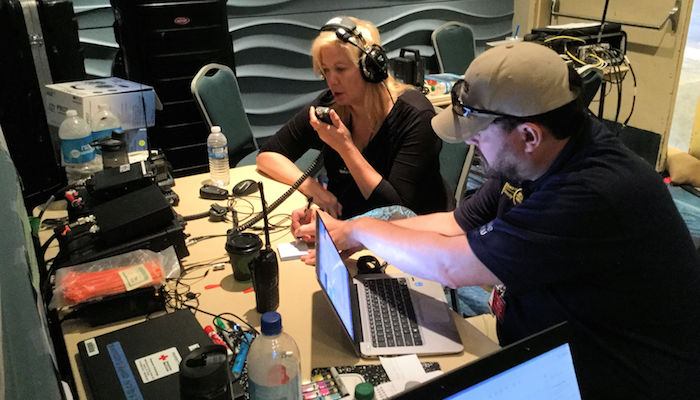
A lot of Hams are preppers. And then the network of people you'll run into earlier and during an emergency are similar-minded and more probable to know what's happening compared to a random CB trucker.
Many Ham radios take a built-in function to hands listen to typical commercial AM/FM radio stations. To the all-time of our noesis, CB radios don't. Some of the mutual FRS/GMRS radios you find at Walmart will have an AM/FM commercial radio characteristic so you can listen to broadcasts on a hike.
Crossover between radio types
Ham is considered the most versatile when it comes to "crossing over" into other types of radio. Take intendance, because some of what yous encounter nearly this on the net is technically illegal — in some cases you're modifying equipment or using it in means that aren't allowed by the alphabetic character of the law.
Ham radios can be used or modified (either through software or hardware) to access the CB, FRS/GMRS, and MURS frequencies. This can be illegal because a Ham radio might broadcast with more power than the FCC allows on lower ability frequencies like CB or FRS. But there are videos showing y'all how to do this on YouTube.
While Ham can affect well-nigh or all of the other radio types, it's essentially impossible to go the other style. You can't brand an FRS radio talk to CB, for example.
Ease of learning and using
This is the major identify where Ham loses vs the other radio formats. All of the other types of radio are designed to exist turnkey.
CB and FRS are the easiest radios to become started with: you lot buy a unit of measurement off the shelf, have everyone in your political party turn it to Channel three, and yous're good to go. The barrier of entry is low, and you don't need a license.
Only there are tradeoffs. When we rest out the pros and cons of each, most survival experts believe the pros of Ham outweigh the actress steps.
Because the government made it easy for anyone to utilise those license-complimentary bands, they require manufacturers to cripple the equipment so that people can't abuse the airwaves or broadcast in places or ways they're not supposed to.
For example, many turnkey radios are prohibited by law from having removable antennas. CB radios can't have upgraded power without breaking the police force. And so on.
CB, FRS, and MURS don't need any kind of license. GMRS does, but there's no test.
Ham requires at least a basic license and test that might take you 2-3 days, including study time. More avant-garde Ham licenses require more studying.
Learning and using the equipment is also harder in Ham than the others. Simply it's the cost nosotros pay to have what we need in the widest range of emergencies.
If y'all personally determine that you'll only ever need to talk to a airtight network of people within a short distance, then the more than turnkey versions like CB or MURS would exist a fine style to go.
Cost of Ham radio vs. the others
If your primary business organization is cost and yous're fine with the tradeoffs, then FRS or CB is better than Ham.
Ham is non nearly as expensive as it used to be. Merely considering the equipment is more powerful and flexible, the costs are generally higher.
A handheld Ham radio, like the popular Baofeng BF-F8HP, can exist as little as $30-seventy.
The real money comes in with mobile units (car mounted) and base stations (home mounted), which can be $500 or more. Although, at that place are enough of DIY and used options.
What is the range of Ham radio, CB, FRS, GMRS, and MURS?
If you ever want to start an internet debate, bring up radio ranges.
It'south incommunicable to give simple numbers that anybody thinks are correct. There are and so many variables that it'due south hard (and technically non 100% right) to give averages. We almost didn't include this section at all, but many people enquire and what'southward important is the relative relationship between the different radio types. In curt, Ham radio beats the other types.
Considering of how variable the range can exist, we've personally experienced situations where nosotros contacted someone 200 miles to the E, but couldn't contact someone 10 miles to the West. In that example, Due east was flat but West had deep mountains.
Range is affected by:
- size and quality of the antenna
- how high the antenna is off the basis / relative to the horizon
- what kind of terrain or structures are in the fashion
- urban vs. rural
- wavelength / frequency
- transmission power
- weather, including unseen stuff like atmospheric layers and solar flares
- Murphy'southward Law 🙁
Those factors are quite different based on what kind of radio equipment you're using. Powered base stations with fixed antennas on your chimney will perform ameliorate than a battery-powered handheld unit with a whip antenna.
Since most people want to keep things simple, we tried to evaluate the boilerplate practical ranges you could dependably achieve in a mix of mutual scenarios and environments.
Average ranges betwixt two boilerplate handheld radios:
- Ham: 2 miles
- CB: 1 mile
- MURS: 1 mile
- GMRS: 0.5 mile
- FRS: 0.25 mile
Average ranges betwixt 2 average base of operations station radios:
- Ham: xviii miles
- CB: 14 miles
- MURS: 10 miles
- GMRS: 9 miles
- FRS: (No base stations due to stock-still antenna and power limit laws)
In general, flat rural areas accept the best range. The more than terrain and structures there are in the way, the shorter the range. The same radio might get x miles in the country, 5 miles in the suburbs, and ane-2 miles in the city.
Y'all volition usually meet marketing for CB and FRS / GMRS / MURS walkie talkies touting ranges of 30-50 miles. They are plainly lying. Those are the theoretical maximums if you lot were standing at the highest point in the region, at night, with flat terrain, no buildings, perfect weather, and a blessing from the Radio Gods.
CB usually has a range of 1-2 miles. That range can be extended with more than advanced CB technology similar Single Side Ring so on. A limitation of CB is that the antennas need to be quite large, which is why CB base stations tin get a decent heave in range with antennas that wouldn't otherwise fit on a vehicle. So nosotros retrieve information technology gets impractical to reach those ranges compared to more modernistic tech like Ham.
MURS has less power than CB and GMRS at 2 watts versus 4-five watts, respectively. However, since VHF has more range than UHF, MURS unremarkably comes out ahead on distance.
GMRS users usually report applied ranges of 0.5 to ane mile. In articulate line of sight situations y'all might get up to two miles.
FRS is usually the shortest range with averages of 0.5 to 1 mile.
Ham'southward signal range varies widely based on the equipment and band you're using. A handheld unit might only get a few miles in some circumstances, while a base station on HF bands tin can bounce off the atmosphere to talk around the globe.
Handheld Hams will usually exist 5-8 watts. But a base station can get up to 1,500 Due west of power!
"Don't just buy a top-rated handheld Ham and expect it to perform well in every location," said Robert Wright, an Extra-class Ham who's been licensed for 26 years.
26-year Ham expert Robert Wright suggests contacting your local CERT group, which tin can recommend the all-time radios and frequencies for your surface area, and nigh importantly, offer training classes and opportunities to exercise using your radio.
UHF, such as the pop 70 cm band, is generally considered line of sight. VHF, including the pop ii m band, is by and large limited past the horizon (which may exist truncated past buildings etc). HF is where Ham gets really stretchy.
Do you need a license to use Amateur (Ham) radio?
Yes — if y'all desire to transmit over the Ham radio frequencies.
Anyone tin can buy Ham radio equipment and listen to whatever signals they can receive. Those signals are floating through the air anyhow, and it's harmless to listen in.
Although nosotros don't recommend information technology, you could buy a unproblematic merely solid Ham radio like the BaoFeng BF-F8HP and heed to nearby traffic, such as your local burn down department. Then, in an emergency, maybe yous could figure out how to transmit or become lucky. No test required.
Anyone tin can transmit on amateur Ham radio without a license in a bona fide emergency. In a real Shit Hit The Fan situation, it'due south of class unlikely anyone will care anyway. But there are hefty fines if y'all're defenseless transmitting outside of an emergency. Aye, it's actually enforced.
You wouldn't buy a gun and wait to shoot it for the showtime time afterward SHTF. The same goes for Ham — you won't automatically be comfortable with information technology the kickoff time you use it. Even though Ham is getting easier to learn, you lot practise all the same demand to learn.
For case, knowing how to access a local bespeak repeater so you tin extend your range from two miles to 50 miles could be the key to saving your life.
Since you are non truly prepared until you practice with your gear, we recommend getting at to the lowest degree the most bones license level so y'all can get to know your radio and how to use it.
If getting a license is simply not an selection for you, many preppers still believe having a ~$l Ham radio is improve than nothing. You might exist able to pick upwardly FM and emergency channels, get lucky by contacting someone else, or run into a group of experienced Hams that can add together you to their network.
Which Ham radio license should you get for prepping?
At that place are three levels of licenses:
- Technician (entry)
- General
- Extra (advanced)
Each of these licenses lasts 10 years and require a test. The major difference between levels is how many frequencies you accept access to.
The entry-level Technician license gives you access to amateur bands in a higher place 30 MHz, including the popular 2 meter and 70 centimeter bands.
The General license gets you into the lower frequency, longer wavelength High Frequency bands that are better for long altitude.
For 99% of people, get-go with the Technician license. fourscore% of you will likely stop at that level.
In one case y'all've learned the ropes, if y'all're serious virtually setting upwardly the equipment to talk hundreds or even thousands of miles away without being dependent on the power filigree or repeaters, y'all'll want admission to the HF bands. So you'll need the General license.
How to get a Ham radio license
Nigh tests are conducted through your local amateur radio guild on a monthly or quarterly basis.
Find your closest Ham testing session on ARRL.
The apprentice radio license test has a minor fee, commonly around $x-15, which can vary between radio clubs.
Volunteer Examiners (VE) administrate the test, and they appreciate the courtesy of a heads upwardly that you plan to attend.
The written, multiple-pick Technician's test is 35 questions. You must get 26 correct to pass.
The VE will form your test on site. If y'all laissez passer, they mail your info to the FCC. Afterwards 1-ii weeks you'll receive your amateur radio license and call sign (e.g. "YX8WU").
Everywhere around the globe has specific call sign blocks assigned to them ("WO_ _ _") to assistance with licensing and identification: Chiliad, Grand & 2E for England, D for Frg, I for Italy, AA-AL, Thou, Westward, N for USA, so on.
You are non immune to talk on the air until you receive your unique phone call sign.
Note that when you lot become licensed with the FCC, your name and address volition be searchable through their ULS organization. Many preppers want to maintain some privacy, so they prepare a P.O. Box or some other accost earlier they apply for a license.
How to prepare for the Amateur (Ham) radio exam
Well-nigh people going for the Technician entry-level license want to get ready for the test as chop-chop every bit possible.
The FCC releases electric current versions of the examination question pools. The 35-50 questions on an exam are randomly pulled from a puddle of ~350.
If y'all like to larn in-person, ARRL has a list of local classes. The intro classes are usually a few days long and cost $10-$fifteen. It'south a swell way to start meeting local Hams.
You tin find gratis online flashcards and practice tests that utilize questions from the real test on QRZ, eHam, ARRL, and Hamstudy.
If you want to dig deeper, cheque out ARRL'southward study guides.
Hams fifty-fifty take a special name for passionate advocates that enjoy teaching newbies: Elmers. Try finding an Elmer to be your mentor via EHam.cyberspace'south Elmer forum.
Radio 101 (in easy terms)
We'll keep the scientific discipline to a minimum, but to empathise things similar the deviation between CB and Ham or how far your signal volition reach, information technology's helpful to understand the basics of radio.
Radio is role of a broader spectrum

There are all kinds of indicate waves effectually us chosen the "electromagnetic spectrum." The visible lite we run across, UV rays from the dominicus, X-rays, microwaves, the signal from your remote command to a TV, GPS, and radio all fall on this spectrum.
The divergence between types of waves is how big and fast the waves are.
Considering different sections of the spectrum work well for unlike jobs (like transmitting TV shows versus cooking nutrient), and to keep the airwaves more than organized, governments create and manage blocks of frequencies for unlike purposes.
Blocks are reserved for satellites, emergency services, military, commercial shipping, CIA mind control devices, commercial radio stations, mobile phones, and and then on.
That'due south why all FM radio stations you heed to in the car are betwixt 88 and 108, which correlates to their frequency of 88 MHz to 108 MHz. AM stations are always between 540 and 1600 KHz.
But not all frequencies are created equal. For case, FM radio stations normally sound clearer than AM radio stations.
The bands used to transmit Hard disk Television signals are different than those used for garage door openers. It boils downwards to how big and fast the waves are, which affects how much info you can package into a signal. Hard disk Television receiver requires more info per 2d than unproblematic talk radio.
What are radio frequencies?
"Frequency" means how often something happens in a specific time window. Fast music might have a frequency of 120 beats per infinitesimal, where slow music might be 66.

In radio, frequency is the number of waves per 2nd. Y'all'll come across frequencies listed similar "840 kHz" or "300 MHz".
Hz stands for Hertz, which ways one moving ridge.
The k, Thou, and G that goes before Hz is for kilo, Mega, and Giga — yeah, the k is lowercase while the others aren't. Merely like on the calculator, where a Kilobyte < Megabyte < Gigabyte.
A Megahertz is one million waves. And so a frequency of 300 MHz would be 300,000,000 waves per second.
What is a wavelength?
This one's easy: a wavelength is the physical length from i point on a wave (similar the peak) to the same point on the next wave.
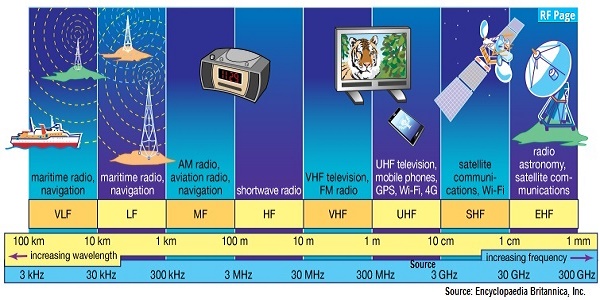
Wavelength and frequency are an inverse relationship. The higher the frequency, the lower the wavelength.
Which makes sense — if a single wave is sixty miles long, it'd exist a lot harder to scrunch 300,000,000 of those waves into one second'due south worth of transmission than if each wave was just an inch long.
What does HF, VHF, and UHF mean?
High Frequency (HF), Very High Frequency (VHF), and Ultra High Frequency (UHF) are names for different bird's eye view sections of the broader radio spectrum.
- High Frequency (HF) is 3-thirty MHz
- Very High Frequency (VHF) is thirty-300 MHz
- Ultra High Frequency (UHF) is 300 MHz to three GHz
There are of course other sections like Low Frequency, but you don't hear much nigh them because they aren't used for noncombatant radio.
The naming can seem confusing, merely consider the history. The first radios were simple. And so scientists thought "this part is low and this part is high". Then, over time, we kept innovating into higher and higher frequencies. "Um, this one is Very Loftier!"… "Now this next ane is Ultra High!" And so on.
What are radio bands?
Bands are ranges or blocks of radio frequencies. They are referred to by their frequency ("14 MHz band") or wavelength ("xx meter band").
There are 27 apprentice radio bands. These are the most popular:
| Range | Band (Meter) | MHz |
|---|---|---|
| HF | 80 | 3.v – iv.0 |
| HF | 40 | 7.0 – vii.iii |
| HF | 30 | 10.1 – ten.15 |
| HF | 20 | 14.0 – 14.350 |
| HF | 17 | eighteen.068 – eighteen.168 |
| HF | 15 | 21.0 – 21.450 |
| HF | 12 | 24.890 – 24.990 |
| HF | x | 28.0 – 29.lxx |
| VHF | 6 | 50 – 54 |
| VHF | 2 | 144 – 148 |
| UHF | 70 cm | 430 – 440 |
But most beginner's focus on just two bands: 2 meter / 144-148 MHz and lxx centimeter / 430-440 MHz.
Additionally, 2 meter and 70 centimeter are the bands used by local emergency radio services such as the Amateur Radio Emergency Service, Radio Amateur Civil Emergency Service, and Community Emergency Response Teams.
What are radio channels?
Radio channels are like email addresses. Instead of telling someone to e-mail your IP accost (172.42.23.163), y'all give them an easier to remember label.
And so when people use Channel 19 on CB radio, they're just referring to the frequency 27.185 MHz that everyone knows as Channel 19.
For the types of radio that are meant to be easy for everyone (CB and FRS), you might non ever see the actual frequency — information technology just has the channels programmed in by default and the equipment knows the residuum.
That's also why we phone call TV stations "channels", considering they used to be transmitted over the air. CBS didn't want to tell their viewers to "tune in to frequency 519.25 MHz!"
Trade off between range and penetration in HF / VHF / UHF
The well-nigh important thing to remember is that long wavelengths travel further and smaller wavelengths can sneak their way into buildings.
10-Rays work because they are so small, they can motility through your body.
The college the radio frequency, the smaller the wavelength. The UHF 70 cm band doesn't become as much natural range equally the VHF 2 m band, but it's better at finding its mode through windows and doors.
On the other finish of the spectrum, the larger wavelengths are able to travel further than the horizon because they can bounce off of the atmosphere, mountains, and fifty-fifty the moon.
This video is a apples-to-apples test betwixt VHF and UHF in an outdoor setting. Even with higher wattage on the UHF model, around two minutes in you tin hear the UHF degrade compared to VHF as they hit the furthest distance before turning around:
Since VHF is the middle-of-the-route compromise between HF distance and UHF ability to pierce buildings, and since most people take their Technician'south license which doesn't allow HF, VHF is normally the near popular band amongst Hams.
Depending on who y'all're trying to contact, yous might opt for 1 band over another. Take Puerto Rico, for case. Later on Hurricane Maria wiped out cellular networks, police worked alongside Ham radio operators equipped with VHF mobile radios so they could talk on the 2 meter band with other emergency crews.
What are Ham radio repeaters?
Even though Ham radio has more inherent range than other options like the FRS walkie talkies, the pop 2m and 70 cm bands available to Technician-level Hams are by and large limited to line-of-horizon or line-of-sight range. If y'all're using a handheld unit of measurement, you may just become 1-2 miles.
Ham radio repeaters are the equivalent of mobile phone towers. They receive a indicate from someone nearby and rebroadcast information technology into the greater network, commonly with more than power and clarity, so information technology can travel further.
Repeaters are usually on summit of a tall building or loma, with high quality equipment and antennas.
They're freely bachelor for public utilize. Repeaters are often set up upwardly and maintained past a local Ham who wanted to volunteer their fourth dimension for public service.
Find your local repeaters with RFinder (the official tally for the ARRL) or RepeaterBook.
If your signal bounces off of merely ane repeater, the range tin can get up to 50 miles. With a stiff network of repeaters, a manual could exist daisy-chained to span the country.
A repeater tin't receive and transmit at the same time on the same frequency, but like normal transceivers. This is called simplex.
Since a repeater essentially needs to mind and repeat at one time, they use two different frequencies that are slightly showtime from each other. This is called duplex.
The practiced news is that most modernistic Ham equipment can manage the duplex offsets automatically. Only it'south a perfect case of why you need to practice (with a license) in order to understand repeaters earlier you need them.
You can't always depend on repeaters existence available in an emergency, since most are powered by the normal electrical grid. Some are powered by solar or generators, but those too tin fail.
In a real SHTF situation, it's safest to assume yous tin only rely on the equipment yous take. That's why avant-garde preppers go their Full general license and move into the longer wavelength HF bands that tin can travel hundreds of miles without repeaters.
Intro to Ham radio equipment for survival
All radios require a ability supply, antenna, and transceiver to send and receive signals. A transceiver is i unit that transmits and receives (get it?!)
Nosotros'll suggest specific products like radios, antennae, and brands in a future post. This is just the nuts.
There are iii bones types:
- Handheld radios. Sometimes chosen Handitalkies or HTs. The popular Baofeng radios are HTs.
- Mobile radios. Mounted in a vehicle, like a typical CB radio.
- Base stations. Typically in your dwelling, with a big immobile antenna (perhaps on your chimney), ability supply, and transceiver.
More: All-time handheld ham radios
Handheld Ham radios
Note that "walkie-talkies" or "two-manner radio" normally hateful the simpler and cheaper Walmart products not meant for survival utilise. They operate on the Family Radio Service frequency bands and are programmed to but talk with each other on a limited set of channels.
The simplest fashion to get started is with a $40-60 handheld radio. The nearly popular beginner options amid preppers are the Baofeng UV-5R and BF-F8HP.
Quick Choice
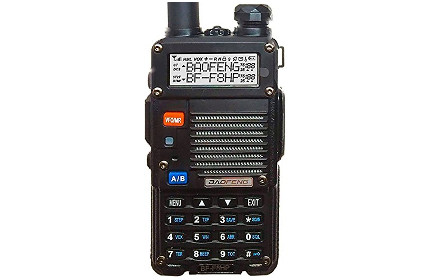
Popular prepper radio:
BaoFeng BF-F8HP 8 Watt Dual Ring Handheld Ham Radio
Ane of the most pop handheld Ham radios considering it'south solid enough for nigh uses, but under $100. third generation of the previously pop UV-5R.
- Check price on Amazon
When you run across the "dual-band" label, that merely means the radio can access two dissimilar bands. In 99% of circumstances, that means it works on the two most popular VHF 2 m and UHF 70 cm bands — both are included in the entry-level Technician license.
Most popular Ham handheld radios use v-8 watts of power off a rechargeable battery. The ARRL suggests a spare rechargeable battery pack, a car adapter, and a desktop quick-charger. Nosotros also accept an adapter that replaces our HT battery with a compartment for four normal AA batteries in case we can't use annihilation else.
Mobile Ham radios
Mobile radios are typically mounted in your vehicle'due south dash, glovebox, or nether a seat with a corded microphone that runs towards the driver'southward seat.
Mobile radios can get at least double the signal range of an HT because of more power from the bombardment and a larger antenna.
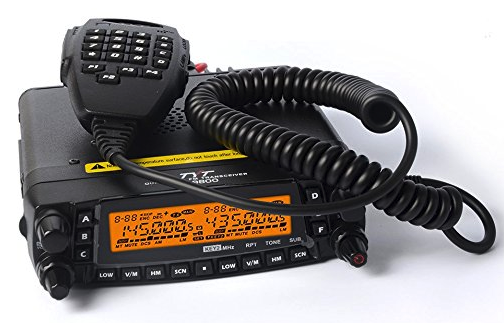
In that location's a variety of ways y'all tin can attach an antenna to your vehicle. There are more fixed solutions where the antenna is bolted or screwed onto an aftermarket mountain that attaches to your hood, roof, tailgate, etc.
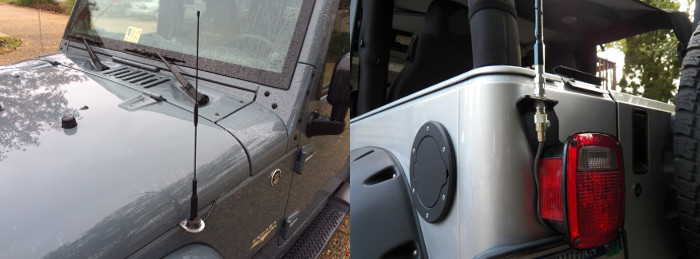
Magnetic mounts are handy because you lot can put up the antenna when you demand information technology, merely quickly remove it when you don't.
Some mobile transceivers are designed to exist removable. They normally sit stationary in a subclass in your vehicle. But the transceiver can be removed, thrown in a backpack, and off you keep human foot.
If you lot get your General license to access the long range HF bands that are bully for prepping, there are portable HF units that tin can fit in a backpack.
A new mobile rig setup could price effectually $500-$800. The transceivers are ordinarily the size of a thick sandwich.
Ham base of operations stations
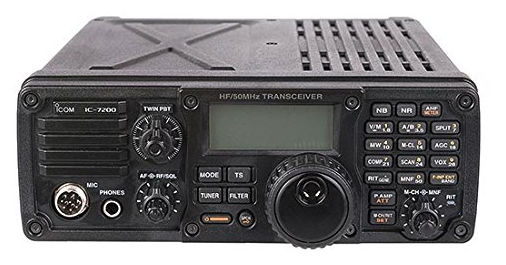
For most people with their own dwelling house, having a base station with external antenna is nifty for prepping. Especially once you accept your General license, which gets you onto the HF bands that tin travel thousands of miles without any repeaters.
They're besides practical for experimenting and modifying. If things really plummet, yous can utilize coat hangers and wire to build makeshift antennas that run up a tree or chimney.
Setting upwards a base station will become close to $ane,000 for new gear. It will be about the size of a Playstation. You tin can often find inexpensive used equipment, simply information technology may be difficult to identify the good used picks until you lot're more experienced.
Ability
None of this matters if the radio doesn't have juice.
Some preppers rely on generators for short term needs, although they are noisy, limited, and require ventilation.
Ideally your home is off the grid anyhow. If it isn't, some preppers accept smaller solar panels and batteries specifically for radio — which many consider to be one of the virtually important electricity needs in an emergency.
If you would like a better idea of what is possible for prepping, every year amateur operators take an event the terminal weekend in June chosen Field Mean solar day, where Hams run radios off of alternative ability.
Antennas are the key
Virtually hams agree that the most important slice of any radio is the antenna. If you want to make your $xl Chinese radio more 'powerful', you tin can easily screw on a ameliorate antenna for equally picayune as $20.
A rule of pollex is the antenna should be at least 1/4 the size of the wavelength yous desire to use. The UHF lxx cm ring but needs a 7 inch antenna. Whereas the 11 m CB ring would need an antenna over 100 inches.
Source: https://theprepared.com/survival-skills/guides/beginners-guide-amateur-ham-radio-preppers/


0 Response to "Best Way to Use a Handheld Ham in a House"
ارسال یک نظر